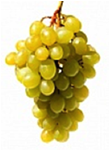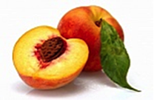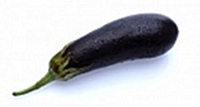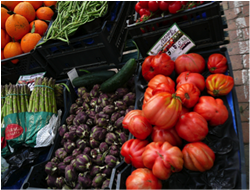CapeWomenOnline - Where Cape Women Shine
Your local venue for the women of Cape Cod to share their ideas, experiences and resources while inspiring each other in their life's journey
Inspire . Encourage . Network . Share

The Art of Eating Well
by Maggie Davis, MS, RD, LDN, FADA, FAND
What do the colors on your plate tell you about your health? Are there vibrant colors in your diet only because the fast food you buy comes colorfully wrapped? Or are your meals filled with the natural color and beauty of a variety fruits and vegetables?
Colorful foods are not only appealing to the eye but reflect a broad spectrum of the nutrients and antioxidants within. As a painter uses different colors and shades of those colors to create a painting, like Paul Cezanne's still life shown above, you can use colors to plan appealing and nutritious meals.
Even the herbs and spices you use to season and garnish your food can contribute to the overall nutritional quality of your food. For example, The turmeric that seasons your curry and makes it a golden color may actually help you to prevent Alzheimer's Disease.
Repaint your plate with colorful fruits and vegetables and replace starchy and refined foods with something each day from each of these color groups. Make your plate a work of art. Add nutrition and subtract calories from your diet at the same time.
Dr. David Heber at UCLA developed the "7 Colors of Health" which groups fruits and vegetables by the colorful pigments that represent the clusters of helpful substances that they contain. Ideally we would eat one item from each of these groups every day to lower the inflammation in our bodies and to reduce our risk of many chronic diseases such as heart disease, vision problems and some types of cancer.
Colorize your diet with a varied palate of fruits, vegetables, spices and herbs from the seven groups listed below:

The yellow-green group includes garlic, onions, celery, white grapes, endive and chives. Onions contain allicin, which is known to have anti-tumor benefits, and other foods in this group contain antioxidant flavonoids such as quercetin and kempferal.

Green vegetables include bok choi, kale, cabbage, broccoli and Brussels sprouts as well as green herbs. These foods are sources of sulforaphane, isocyanate and indoles which help your liver to produce enzymes that break down carcinogens in our bodies.

Avocado is from the yellow-green group which also includes foods such as spinach, collard greens, corn, green peas and honeydew melon. These foods are rich in carotenoids such as lutein and zeanthin which can promote eye health.

The orange/yellow group includes peaches, oranges, clementines and papayas. These foods contain carotenoids and other important nutrients such as Vitamin C.

The orange group is a rich source of alpha and beta carotenes. This group includes orange peppers, carrots, apricots, winter squash, pumpkin and sweet potatoes.

The red group includes tomatoes, pink grapefruit and watermelon which contain lycopene. We absorb more lycopene from cooked tomato products such as tomato sauce and tomato soup since cooking ruptures the cell membrane and makes the lycopene more available for absorption.

The red/purple group includes eggplant, red wine, cranberries, blueberries, blackberries, strawberries and red apples. These foods contribute anthocyanins which help to inhibit blood clot formation.

Seven Steps to Break the Boring Beige Diet Pattern…
- Stop filling your shopping cart full of processed food with colorful packing and start spending more time in the produce aisle of your market looking for whole, minimally processed foods that have vibrant, beautiful, natural color.
- It's okay to bring home green peas, blueberries and other fruits and vegetables that are frozen. These frozen items have been packed when the produce has just been picked and the freezing reserves the nutrients present at harvesting. Just avoid the packages that have added sauces or cheese. You can add your own seasonings at home, e.g. defrost frozen spinach, then sauté some garlic slices in a pan with a little olive; add the spinach for another minute or two so that it absorbs the flavors.
- If you are using jarred or canned produce look for vegetables that are unsalted and fruits that are unsweetened. These are an acceptable substitute for foods that may be out of season or unavailable to you locally.
- Try a new fruit or vegetable each week. Look for seasonal items that are often fresher and less expensive than items that are out of season or imported from other countries.
- Repaint your plate: Include 3 colors per meal, for example, a tuna roll-up with baby spinach and roasted red peppers along with a Clementine or two…
- Be an artist in your own kitchen. Just as an artist has materials to work with you can keep your refrigerator and pantry stocked with healthy ingredients that are full of color. And you can also add beauty to your meals using attractive dishes, placements and table settings.
- Look for simple recipes that feature healthy whole foods with color and beauty.
All images courtesy of Maggie Davis

For Maggie's recipe ideas visit www.LiveNutrition.com
Click here for class details
or call Maggie for start dates
508-896-9080

Maggie Davis, MS, RDN, LDN, FADA, FAND is the founder and director of Live Nutrition Inc. in Brewster, MA. She has been in practice for 30 years on Cape Cod.
Maggie has a passion for educating and inspiring her patients and clients live healthier lives through better nutrition. Maggie is also a gourmet cook who combines nutrition and style in the meals she prepares.
Maggie is an Advanced Practice Nutritionist/Dietitian as well as a Fellow of the American Dietetic Association and a Fellow of the Academy of Nutrition and Dietetics. In addition to her clinical work at Live Nutrition, she is an author, and a consultant to companies developing food products and conducting nutrition research. Her latest book is Good Food for Life. Maggie lives in Harwich with her husband, Steve, where they love tending their organic garden.
To contact Maggie email MaggieDavis@comcast.net
You can subscribe to Maggie's e-newsletter by logging on to www.LiveNutrition.com



